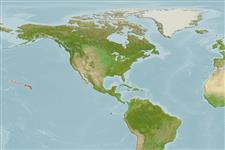Teleostei (teleosts) >
Kurtiformes (Nurseryfishes, cardinalfishes.) >
Apogonidae (Cardinalfishes) > Pseudamiinae
Etymology: Pseudamiops: Greek, pseudes = false + Greek, amia = a kind of shark + Greek, ops = appearance (Ref. 45335); diaphanes: Named for its transparency.
More on author: Randall.
Environment: milieu / climate zone / depth range / distribution range
Ecology
Marine; reef-associated; depth range 3 - 25 m (Ref. 27665). Tropical
Eastern Central Pacific: Hawaii and Johnston islands.
Size / Weight / Age
Maturity: Lm ? range ? - ? cm
Max length : 3.3 cm SL male/unsexed; (Ref. 27665); 3.0 cm SL (female)
Found in caves (Ref. 27665). Benthopelagic (Ref. 58302). Caught by hand net at night and also with the use of rotenone (Ref. 27665).
Life cycle and mating behavior
Maturity | Reproduction | Spawning | Eggs | Fecundity | Larvae
Distinct pairing during courtship and spawning (Ref. 205).
Randall, J.E., 1998. Review of the cardinalfishes (Apogonidae) of the Hawaiian Islands, with descriptions of two new species. aqua, J. Ichthyol. Aquat. Biol. 3(1):25-38. (Ref. 27665)
IUCN Red List Status (Ref. 130435: Version 2024-1)
Threat to humans
Harmless
Human uses
Tools
Special reports
Download XML
Internet sources
Estimates based on models
Preferred temperature (Ref.
123201): 24.9 - 25.6, mean 25.3 °C (based on 31 cells).
Phylogenetic diversity index (Ref.
82804): PD
50 = 0.5312 [Uniqueness, from 0.5 = low to 2.0 = high].
Bayesian length-weight: a=0.00389 (0.00180 - 0.00842), b=3.12 (2.94 - 3.30), in cm total length, based on all LWR estimates for this body shape (Ref.
93245).
Trophic level (Ref.
69278): 3.2 ±0.5 se; based on size and trophs of closest relatives
Resilience (Ref.
120179): High, minimum population doubling time less than 15 months (Preliminary K or Fecundity.).
Fishing Vulnerability (Ref.
59153): Low vulnerability (10 of 100).
